NIH Consensus Conference on Celiac Disease (2004) and NIDDK Celiac Disease Awareness Campaign PowerPoint Presentation
Slide 1
NIH Consensus Conference on Celiac Disease (2004) and NIDDK Celiac Disease Awareness Campaign
Stephen P. James, M.D.
National Institute of Diabetes and Digestive and Kidney Diseases (NIDDK), National Institutes of Health (NIH)
November 9, 2006
Slide 2
Office of the Medical Applications of Research (OMAR), Office of Disease Prevention, NIH
http://odp.od.nih.gov/omar
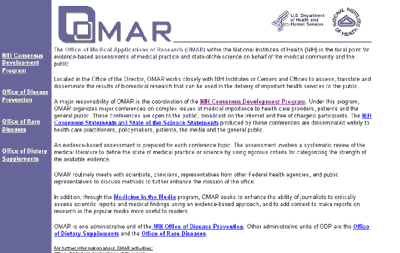
Notes
The Office of Medical Applications of Research (OMAR) is responsible for organizing major conferences on complex issues of medical importance to health care providers, patients, and the general public. The NIDDK worked with OMAR to convene the NIH Consensus Conference on Celiac Disease.
Slide 3
Rationale for NIH Consensus Conference on Celiac Disease
- The disease is relatively common in the United States, yet it is largely underdiagnosed (limited awareness)
- Protean manifestations require awareness in the general medical community
- Initial diagnostic steps and management suitable for general pediatrics, family medicine, and general internal medicine
- A highly effective treatment is available (gluten-free diet)
- New information is available about prevalence and diagnostic tests
Slide 4
Format of Consensus Conference
- Independent consensus panel of nonbiased scientists, physicians, and public interest representatives
- Presentations by experts in the field
- Analysis of scientific evidence by Evidence-Based Practice Group
- Solicitation of public comments
- Statement by independent panel to address the following questions:
Slide 5
NIH Consensus Conference: Celiac Disease
June 28 to 30, 2004
- How is celiac disease diagnosed?
- How prevalent is celiac disease?
- What are the manifestations and long-term consequences of celiac disease?
- Who should be tested for celiac disease?
- How is celiac disease managed?
- What are recommendations for future research on celiac disease and related conditions?
Slide 6
Conclusions of Consensus Panel
http://consensus.nih.gov/2004/2004CeliacDisease118html.htm
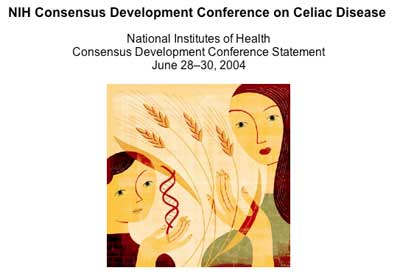
Notes
The Consensus Panel concluded that heightened awareness of celiac disease is imperative and that education of physicians, registered dietitians, and other health care providers is needed. The Panel recommended
- education of physicians, dietitians, nurses, and the public about celiac disease by a trans-NIH initiative led by the NIDDK together with the Centers for Disease Control and Prevention
- standardization of serologic tests and pathologic criteria for diagnosing celiac disease
- adoption of a standard definition of a gluten-free diet based on objective evidence such as that developed by the American Dietetic Association
- development of an adequate testing procedure for gluten in foods and definition of standards for gluten-free foods in the United States to lay the foundation for rational food labeling
- formation of a federation of celiac disease societies, celiac disease interest groups, individuals with celiac disease and their families, physicians, dietitians, and other health care providers for the advancement of education, research, and advocacy for individuals with celiac disease
Slide 7
Consensus Conference Proceedings
- Full proceedings of Consensus Conference published as a supplement to the April 2005 issue of Gastroenterology
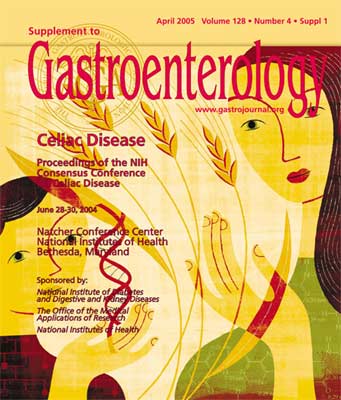
Notes
Gastroenterology, April 2005, Volume 128, Number 4, Supplement 1
Slide 8
NIH Celiac Disease Consensus Conference Panel Recommendation
- Education of physicians, dietitians, nurses, and the public about celiac disease by a trans-NIH initiative, to be led by the NIDDK, in association with the Centers for Disease Control and Prevention
Notes
This recommendation by the Consensus Panel laid the foundation for the development of the Celiac Disease Awareness Campaign.
Slide 9
National Digestive Diseases Information Clearinghouse (NDDIC), NIDDK
http://digestive.niddk.nih.gov
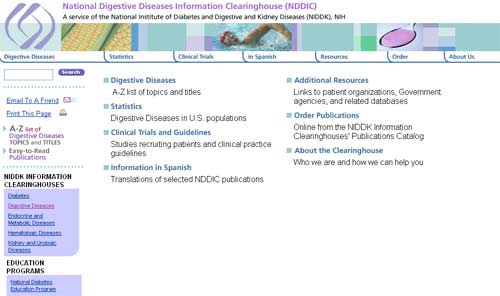
Notes
The National Digestive Diseases Information Clearinghouse (NDDIC) was given responsibility for developing the Celiac Disease Awareness Campaign. NDDIC is an information dissemination service of the NIDDK. The NDDIC was established in 1980 to increase knowledge and understanding about digestive diseases among people with these conditions and their families, health care professionals, and the general public. To carry out this mission, NDDIC works closely with a coordinating panel of representatives from Federal agencies, voluntary organizations on the national level, and professional groups to identify and respond to informational needs about digestive diseases.
Slide 10
Initial Planning Steps
- Form Ad hoc Committee made up of representatives from the research and celiac disease patient communities
- Identify preliminary components and structure of the Awareness Campaign
Notes
Following the Consensus Conference, the NIDDK asked a small group of representatives from the research and celiac disease patient communities to help provide initial campaign planning direction. This ad hoc committee agreed that the Awareness Campaign should focus on the message that celiac disease is more common than previously thought and that its symptoms are broad.
Slide 11
Target Audiences
Primary Targets
- Primary Care Providers
- Pediatricians
- OB/GYNs
- Physician Assistants
Secondary Targets
- Endocrinologists
- Nurse Practitioners
- Hematologists
- Allergists
- Dermatologists
- Dentists
Notes
The ad hoc committee agreed that primary care providers, those who are likely to see patients first and make timely referrals to a specialist, should be the primary target audience. The committee also identified secondary target audiences who, because of their specialties, might be likely to see patients with celiac disease and contribute to earlier diagnosis.
Slide 12
Formative Research
- Intercept interviews with nurse practitioners and physician assistants, May 2005
- Focus groups with primary care providers, Fall 2005
Notes
The ad hoc committee suggested conducting formative research with primary care providers to determine what they perceived to be the challenges to diagnosing celiac disease and what tools and information would be useful in overcoming those challenges. In May 2005, intercept interviews were conducted with nurse practitioners and physician assistants at the National Conference of Nurse Practitioners and the American Academy of Physician Assistants meetings. In Fall 2005, the NDDIC conducted eight focus groups in the four cities with primary care providers—family practitioners, internists, OB/GYNs, and pediatricians.
Slide 13
Intercept Interviews
Nurse Practitioners and Physician Assistants
- Most nurse practitioners and physician assistants had not been involved in diagnosing a person with celiac disease
- The majority rely on a variety of resources when seeking disease information
- Those interviewed suggested disseminating information about celiac disease through conference presentations, journal articles, one-page fact sheets, direct mail, and advertisements
Notes
Most nurse practitioners and physician assistants interviewed said they rely on online subscription services, WebMD, medical journals, conferences, reference books, or consultations with colleagues when seeking disease information. They also recommended a quick reference guide and continuing education credits as useful ways of providing information and increasing awareness about celiac disease.
Slide 14
Focus Groups
Primary Care Providers
- do not trust claims of a 1-percent prevalence of celiac disease
- are unsure of the sensitivity and specificity of blood tests
- do not perceive underdiagnosis of celiac disease to be problematic or have long-term consequences
- are already overwhelmed with information
Notes
Physicians participating in the primary care provider focus groups answered a wide range of questions to assess awareness of celiac disease and barriers to diagnosis. Many of the physicians said they were already “overwhelmed” with information and that celiac disease was a “third-tier” disease. They were more concerned with “first-tier” diseases they see much more often, such as diabetes, hypertension, and cardiovascular disease.
Slide 15
Campaign Goal
Educate the medical community about the
- prevalence of celiac disease
- issues of blood testing and its validity
- health consequences of celiac disease
- need to view celiac disease as not only a gastrointestinal disease
Slide 16
Strategies for Reaching Primary Care Providers
Develop tools to help primary care providers recognize, diagnose, and manage celiac disease
- Website information
- Journal articles
- Presentations at national meetings
- Textbooks and medical curriculums
Develop health information tools for primary care providers to distribute to patients
Slide 17
Communication Channels
- Campaign website (www.celiac.nih.gov)
- Consensus statement
- Celiac Disease News
- Other publications/Awareness Campaign articles
Slide 18
Celiac Disease Awareness Campaign Website
www.celiac.nih.gov
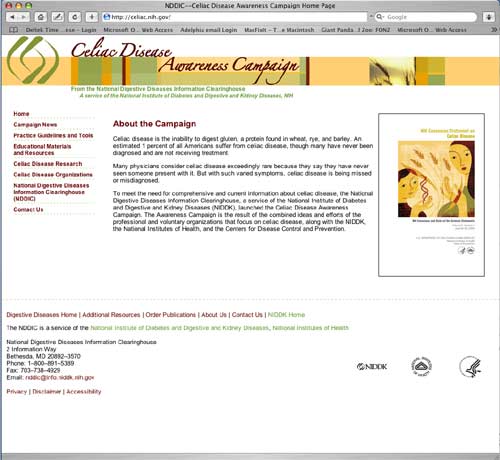
Notes
The Celiac Disease Awareness Campaign, featuring the Awareness Campaign website, was launched in July 2006.
Slide 19
Campaign Website Features
- Campaign news and events
- Practice guidelines and tools
- Educational materials and resources
- Celiac disease research
- Celiac disease organizations
Slide 20
Celiac Disease News
- Communicate with celiac disease community about Awareness Campaign developments, features, resources, and upcoming events
- Subscribe online at www.celiac.nih.gov/news.aspx
Notes
The website features the current issue of Celiac Disease News and an archive of past issues.
Slide 21
Publications
- Celiac Disease fact sheet
- What I need to know about Celiac Disease easy-to-read booklet
- Awareness Campaign articles
Other Publications from the NIH
- What People With Celiac Disease Need to Know About Osteoporosis
Notes
What People With Celiac Disease Need to Know About Osteoporosis was produced by the National Institute of Arthritis and Musculoskeletal and Skin Diseases and is available at www.niams.nih.gov/Health_Info/Bone/Osteoporosis/Conditions_Behaviors/celiac.asp.
Slide 22
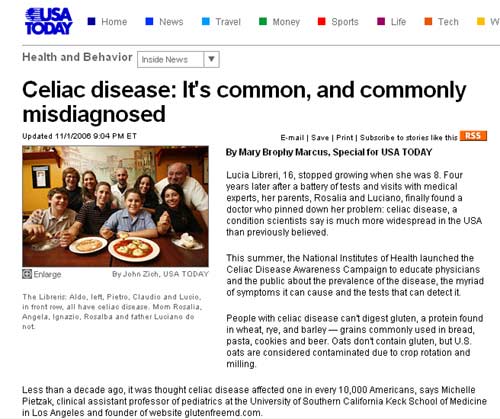
Notes
In addition to being mentioned in a November 1, 2006, article on celiac disease in USA Today, a national newspaper that reaches 5 million readers, the Awareness Campaign received press from WABC New York Radio, which has 250,000 listeners in the New York metropolitan area; PR Newswire, which reaches more than 4,700 newsrooms, 3,600 websites and online databases, and 80,000 journalists nationwide; and NIH News in Health, a monthly newsletter mailed to 6,500 senior centers, medical libraries, and community health clinics around the country. The online version of the newsletter receives about 20,000 hits per month.






